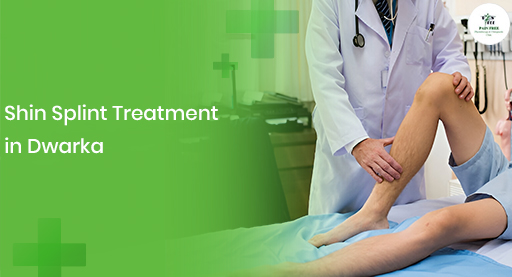Shin Splint Treatment in Dwarka
You lace up your shoes, ready to hit the pavement or breeze through your morning walk. But there it is again that dull, nagging pain along your shin that just won’t quit. Sound familiar? If you’re nodding along, you might be dealing with the not-so-fun reality of shin splints.
Now, here’s the kicker: ignoring it only makes things worse. But don’t worry if you’re in Delhi’s buzzing suburb, you’re in luck. Shin Splint Treatment in Dwarka isn’t just about ice packs and hoping for the best. It’s about science-backed physiotherapy, smart recovery, and getting you back to doing what you love without the pain tagging along.
What Are Shin Splints, Anyway?
Before we dive into treatment, let’s break down what’s actually going on.
Shin splints, also known by the tongue-twister medical term medial tibial stress syndrome, usually feel like a stabbing or aching pain along the inner edge of your shinbone (tibia). It’s common in runners, dancers, or anyone who’s suddenly upped their activity level.
Common Symptoms
- Dull ache in the front or inner part of your lower leg
- Tenderness or soreness along the shin
- Pain that worsens with exercise and eases with rest
- Mild swelling in the lower leg
It might feel like a nuisance at first, but without proper care, shin splints can knock you off your fitness game for weeks or worse, lead to a stress fracture. Yikes.
Why Do Shin Splints Happen?
Ah, the million-rupee question! Shin splints often creep in when the muscles, tendons, and bone tissues around your shinbone get overworked. That usually happens because of:
- Overtraining or rapid increase in activity
- Improper footwear with little cushioning
- Running on hard surfaces like concrete or asphalt
- Flat feet or high arches
- Poor biomechanics (your walking/running style is off)
- Weak core or hip muscles throwing your form off balance
Sometimes, it’s not about doing something wrong, but doing too much, too soon. We’ve all been there.
Shin Splint Treatment in Dwarka: What Sets It Apart?
Now, here’s the part that’ll make you want to stretch those legs again.
Dwarka, a growing medical hub in Delhi, has stepped up its game when it comes to physiotherapy and sports rehab. Clinics here offer personalized tratment and holistic Shin Splint Treatment that doesn’t just dull the pain it tackles the root of it.
Let’s walk through what the treatment usually looks like.
The Go-To Shin Splint Treatment in Dwarka Clinics
1. Physiotherapy That Works Like a Charm
Dwarka’s physio centers take a well-rounded approach. They’ll assess your walking pattern (a.k.a. gait analysis), look at muscle imbalances, and build a plan that’s tailored to you, not some one-size-fits-all routine.
Techniques often used:
- Deep tissue massage to ease tight calf muscles
- Myofascial release to improve flexibility
- Dry needling or cupping (depending on the clinic)
- Electrotherapy (like TENS) to manage pain and inflammation
2. Stretching and Strengthening Galore
Shin splints often mean some muscles are slacking while others are overdoing it.
You’ll likely be guided through:
- Calf stretches
- Ankle mobility drills
- Strengthening exercises for glutes, quads, and core
- Balance and stability work to correct your foot strike
Trust us it’s not just about fixing the pain, but making sure it doesn’t sneak back in.
3. Custom Footwear Guidance
Ever tried running in worn-out sneakers? Yeah, bad idea.
Clinics offering Shin Splint Treatment in Dwarka often include footwear assessment and may even recommend custom orthotics if you’ve got structural issues like flat feet or overpronation.
4. Education and Load Management
It’s not just about rehab it’s about being smart moving forward.
You’ll learn:
- How to gradually increase activity without overloading
- Warm-up and cool-down routines that matter
- How to listen to your body (before it starts screaming at you)
When Should You See a Physiotherapist?
You might be wondering, “Isn’t this something I can fix at home with some rest and ice?” Well, yes and no.
You should see a physio if:
- Pain lasts more than a few days despite resting
- It returns every time you resume running
- The ache is sharp or keeps you from walking normally
- Swelling is visible and persistent
Don’t wait until it turns into something worse. Early treatment = quicker bounce back.
How Long Does Recovery Take?
With consistent physiotherapy and proper rest, most cases improve within 2 to 6 weeks. Of course, it depends on how long you’ve had the problem, your general health, and how closely you follow the rehab plan (no skipping leg day!).
Quick Tips for Preventing Shin Splints
An ounce of prevention really is worth a pound of cure especially when it comes to shin pain.
Do this to keep shin splints at bay:
- Ease into activity don’t go from 0 to 100 overnight.
- Cross-train mix in low-impact workouts like cycling or swimming.
- Replace shoes regularly especially if you’re a runner.
- Stretch daily, even if it’s just five minutes.
- Strengthen your core yep, even for your legs.
FAQs About Shin Splint Treatment in Dwarka
Q: Is physiotherapy for shin splints painful?
A: Some techniques like deep tissue massage or dry needling can feel intense, but they’re generally tolerable and totally worth the relief after.
Q: Do I need an X-ray or MRI before starting treatment?
A: Not always. Most cases of shin splints can be diagnosed clinically, but your therapist may recommend scans if they suspect a stress fracture or other complications.
Q: Can I still walk or work out during treatment?
A: That depends on your pain level. Your physio will usually guide you through modified activities to stay active without overloading your shins.
Q: What’s the best clinic for Shin Splint Treatment in Dwarka?
A: There are several well-rated physiotherapy and sports rehab centers in Dwarka. Look for ones with certified sports physiotherapists, gait analysis tools, and personalized plans.
Q: Are orthotics really necessary?
A: If you have flat feet, overpronation, or structural imbalances, orthotics can make a world of difference. Your physiotherapist will assess and recommend based on need.
Conclusion: Kick Shin Pain to the Curb For Good
Let’s face it, shin splints are a real buzzkill. But they don’t have to be your new normal. With the right Shin Splint Treatment in Dwarka, you can heal fast, move better, and keep doing what you love minus the hobbling.
Whether you’re a weekend jogger, a die-hard athlete, or someone who just wants to walk pain-free, Dwarka’s expert physiotherapists have got your back (and your legs). Don’t wait for the pain to get louder. Take the first step literally and get the care you deserve.









